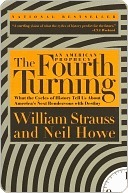More on this book
Community
Kindle Notes & Highlights
Read between
July 16 - July 30, 2020
We yearn for civic character but satisfy ourselves with symbolic gestures and celebrity circuses. We perceive no greatness in our leaders, a new meanness in ourselves. Small wonder that each new election brings a new jolt, its aftermath a new disappointment.
we realize that millions of self-actualized persons don't add up to an actualized society. Popular trust in virtually every American institution—from businesses and governments to churches and newspapers—keeps falling to new lows.
Over the past five centuries, Anglo-American society has entered a new era—a new turning—every two decades or so.
Turnings come in cycles of four. Each cycle spans the length of a long human life, roughly eighty to one hundred years, a unit of time the ancients called the saeculum.
The risk of catastrophe will be very high. The nation could erupt into insurrection or civil violence, crack up geographically, or succumb to authoritarian rule. If there is a war, it is likely to be one of maximum risk and effort—in
the core Christian ritual—the yearly celebration of a dying and reborn savior—still resembles the regenerative midwinter rituals of the archaic religions it superseded. But by degrees, cyclical time as a living faith has been pushed ever deeper into obscurity.
With artificial light, we believe we defeat the sleep-wake cycle; with climate control, the seasonal cycle; with refrigeration, the agricultural cycle; and with high-tech medicine, the rest-recovery cycle.
A linear society defines explicit moral goals (justice, equality) or material goals (comfort, abundance) and then sets out deliberately to attain them.
Yet the great weakness of linear time is that it obliterates time's recurrence and thus cuts people off from the eternal—whether in nature, in each other, or in ourselves.
The society that believes in cycles the least, America, has fallen in the grip of the most portentous cycle in the history of mankind.
One beats to the length of a long human life. The Etruscans ritualized it and the Romans first gave it a name: the saeculum. Today, it loosely goes by the name of siecle, or “century.”
The other rhythm beats to the four phases of a human life, each about twenty years or so in length. What the ancient Greeks called genos, and what we call the generation, has been known, named, and respected as a force in history by practically every civilization since the dawn of time.
Americans carry deeply felt associations with what has happened at various points in their lives. We memorialize public events (Pearl Harbor, the Kennedy and King assassinations, the Challenger explosion) by remembering exactly what we were doing at the time. As we grow older, we realize that the sum total of such events has in many ways shaped who we are.
Like a person (and unlike a race, religion, or sex), a generation is mortal:
This dynamic of generational aging and dying enables a society to replenish its memory and evolve over time.
A Prophet generation is born during a High. A Nomad generation is born during an Awakening.
A Hero generation is born during an Unraveling. An Artist generation is born during a Crisis.
Every Fourth Turning starts with a catalyst event that terminates the mood of Unraveling and unleashes one of Crisis.


